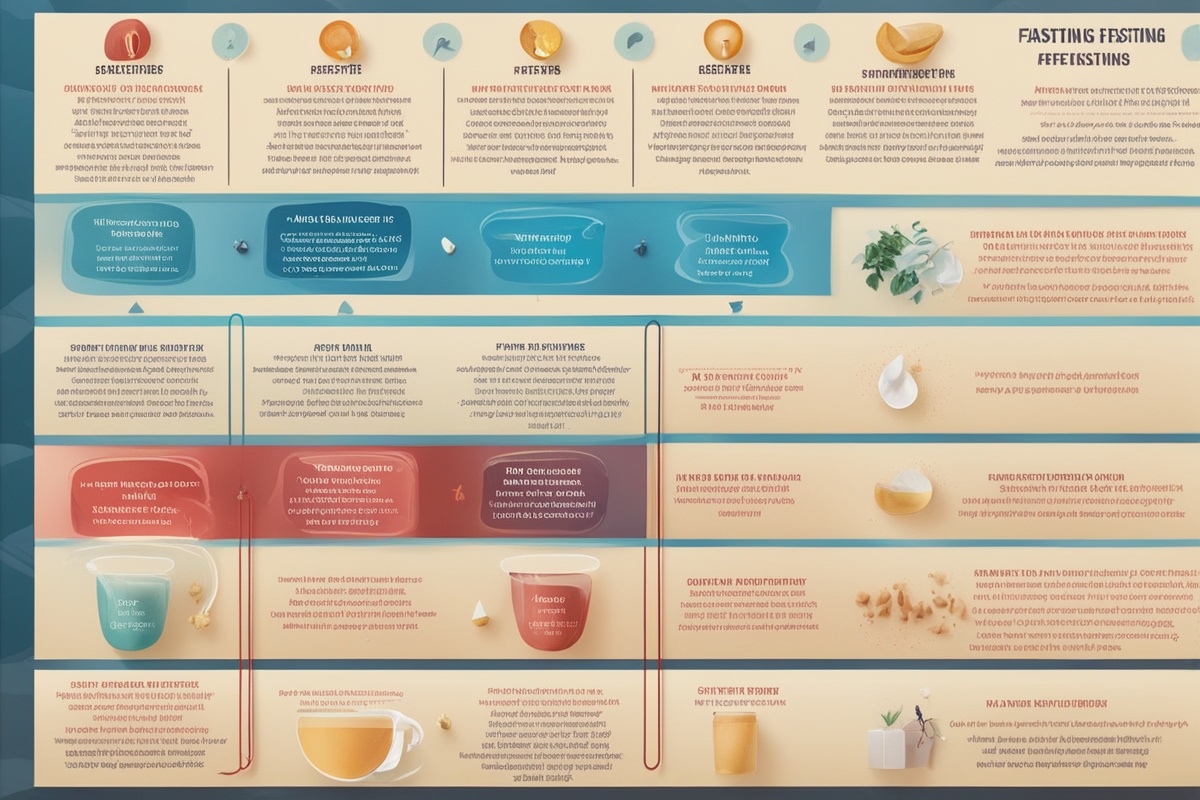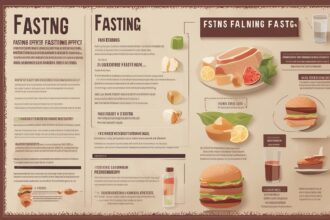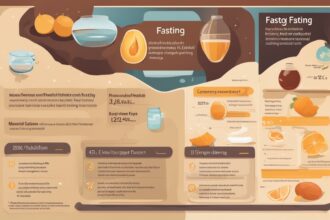Hey there, fasting enthusiasts! If you’re diving into the world of fasting—whether it’s intermittent fasting, water fasting, or another method—you’ve probably heard about the incredible fasting benefits like weight loss, improved mental clarity, and better metabolic health. But let’s be real: fasting isn’t all sunshine and rainbows. There are side effects that can catch you off guard if you’re not prepared. In this post, we’re going to unpack the less glamorous side of fasting, explore why these effects happen, and share practical tips to help you navigate them. Armed with science and real-world advice, you’ll be better equipped to enjoy the perks of fasting while minimizing discomfort. Let’s dive in!
Understanding Fasting and Its Impact on the Body
Fasting, at its core, is about giving your body a break from constant food intake. Whether you’re skipping meals for 16 hours a day or going days with just water, your body shifts gears. It moves from relying on glucose (from food) for energy to tapping into stored fat through a process called ketosis. This metabolic switch is behind many fasting benefits, such as improved insulin sensitivity and fat loss (Mattson et al., 2017). But this shift also triggers changes that can feel uncomfortable, especially if you’re new to fasting. Your body isn’t used to running on empty, and it might protest with symptoms like hunger pangs or fatigue. Understanding these reactions is the first step to managing them effectively.
Common Side Effects of Fasting: What to Expect
When you start fasting, your body is adapting to a new normal, and that can come with a few bumps. Here are some of the most common side effects people experience when chasing those fasting health benefits. Don’t worry—most of these are temporary and manageable with the right approach.
- Hunger and Cravings: This one’s a no-brainer. When you’re not eating, your stomach growls, and your brain might scream for a snack. This is often due to ghrelin, the hunger hormone, spiking initially (Cummings et al., 2002).
- Fatigue and Low Energy: Without a steady stream of calories, you might feel sluggish, especially in the first few days as your body adjusts to burning fat for fuel.
- Headaches: Dehydration or low blood sugar can trigger headaches, a common complaint during the early stages of fasting (Torelli et al., 2010).
- Irritability: Ever heard of being “hangry”? fasting can mess with your mood, partly due to fluctuating blood sugar levels or lack of sleep.
- Digestive Issues: Some people report bloating or constipation when they resume eating, as the digestive system takes time to ramp back up.
Why Do These Side Effects Happen?
Let’s get a bit nerdy for a moment and dig into the science behind these fasting side effects. When you fast, your body undergoes stress as it adapts to a lack of incoming energy. Blood sugar levels drop, which can lead to fatigue and irritability. Dehydration often creeps in because people forget that food provides a significant amount of water—skip meals, and you might not drink enough to compensate (Institute of Medicine, 2005). Additionally, electrolyte imbalances, like low sodium or potassium, can cause headaches or muscle cramps, especially during longer fasts (Kerndt et al., 1982). The good news? Most of these effects are your body’s way of saying, “Hey, I’m figuring this out!” With time and proper care, they often fade as you reap the intermittent fasting benefits.
Who’s at Risk for Serious Side Effects?
While fasting can be a game-changer for many, it’s not a one-size-fits-all solution. Certain groups should approach fasting with caution or avoid it altogether due to the risk of severe side effects. If you’re in one of these categories, consult a healthcare provider before starting a fasting regimen to ensure you can still enjoy fasting advantages safely.
- Pregnant or Breastfeeding Women: Nutrient needs are higher during these periods, and fasting could harm both mother and baby.
- People with Diabetes: Fasting can cause dangerous blood sugar swings, especially for those on insulin or other medications (American Diabetes Association, 2020).
- Individuals with Eating Disorders: Fasting might trigger unhealthy behaviors or exacerbate conditions like anorexia or bulimia.
- Those with Chronic Conditions: If you have heart disease, kidney issues, or other serious health concerns, fasting could strain your system.
Tips to Minimize Fasting Side Effects
Now that we’ve covered the “what” and “why” of fasting side effects, let’s talk about the “how”—as in, how to keep them at bay. I’ve been there, feeling cranky and lightheaded during my first few fasts, but with these strategies, you can smooth out the rough edges and focus on the fasting wellness benefits. Here’s what works:
First, start slow. If you’re new to fasting, don’t jump into a 72-hour water fast right away. Ease into it with a 12:12 schedule (12 hours fasting, 12 hours eating) before progressing to 16:8 or beyond. This gives your body time to adapt. Second, stay hydrated. Drink water like it’s your job—add a pinch of salt or electrolyte drops if you’re fasting for more than a day to prevent imbalances. Third, prioritize sleep. Lack of rest can amplify irritability and fatigue, so aim for 7–9 hours a night. Lastly, listen to your body. If you feel dizzy or unwell, break your fast with a small, nutrient-dense meal like a banana or avocado toast. Fasting is about health, not punishment.
Long-Term Considerations and When to Seek Help
fasting can be a sustainable lifestyle choice for many, offering long-term fasting health advantages like reduced inflammation and better heart health (Mattson et al., 2017). However, prolonged or extreme fasting without proper guidance can lead to issues like nutrient deficiencies, muscle loss, or even refeeding syndrome—a dangerous condition when food is reintroduced after extended fasts (Mehanna et al., 2008). If you experience persistent symptoms like severe dizziness, fainting, or extreme weakness, it’s time to stop and seek medical advice. Remember, the goal of fasting is to enhance your well-being, not to push your body to its breaking point. Keep a journal to track how you feel during fasts—it’s a great way to spot patterns and adjust your approach.
In wrapping up, fasting can be a powerful tool for health and wellness, with fasting benefits that range from weight management to improved mental focus. But it’s not without its challenges. Side effects like hunger, fatigue, and headaches are common, especially in the beginning, but they’re often manageable with preparation and patience. By starting slowly, staying hydrated, and listening to your body, you can minimize discomfort and maximize the fasting health benefits. If you’re ever in doubt or belong to a high-risk group, don’t hesitate to chat with a doctor or dietitian. Fasting is a personal journey, and with the right mindset and strategies, you can make it a rewarding one. So, have you tried fasting yet? Drop a comment with your experiences—I’d love to hear how you’ve navigated the ups and downs!
References
- American Diabetes Association. (2020). Standards of medical care in diabetes—2020. Diabetes Care, 43(Suppl 1), S1–S212.
- Cummings, D. E., Purnell, J. Q., Frayo, R. S., Schmidova, K., Wisse, B. E., & Weigle, D. S. (2002). A preprandial rise in plasma ghrelin levels suggests a role in meal initiation in humans. Diabetes, 50(8), 1714–1719.
- Institute of Medicine. (2005). Dietary reference intakes for water, potassium, sodium, chloride, and sulfate. National Academies Press.
- Kerndt, P. R., Naughton, J. L., Driscoll, C. E., & Loxterkamp, D. A. (1982). Fasting: The history, pathophysiology and complications. Western Journal of Medicine, 137(5), 379–399.
- Mattson, M. P., Longo, V. D., & Harvie, M. (2017). Impact of intermittent fasting on health and disease processes. Ageing Research Reviews, 39, 46–58.
- Mehanna, H. M., Moledina, J., & Travis, J. (2008). Refeeding syndrome: What it is, and how to prevent and treat it. BMJ, 336(7659), 1495–1498.






